There are several reasons why water-soluble, air-soluble, and “erasable” transfer pens for tracing embroidery designs make me a bit nervous. One reason is that the pens are made of a chemical substance that, in the long run, may affect fabric and threads. I tend to think that anything too chemical-ish is not the best choice to use on a fabric. Another reason is because I don’t trust them on two points: 1. I have witnessed a discoloration of fabric / threads from them; and 2. I have witnessed them re-appear as magically as they disappear.
That being said, on cotton fabric with colored cotton thread (for example, household projects like flour sack towels or pillowcases), I have used them to good effect, without any problems.
I recently procured an “erasable” water-soluble transfer pen, and I thought I’d give it a try. I was really curious about this “erasable” part! Was it a gimmick? I was also curious about how fine a line the pen would draw. Fine lines, even with marks that will wash away, are important to me in a transfer – the finer the line, the more accurately the line can be followed while stitching.
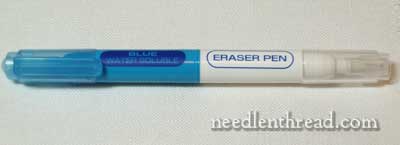
This is the pen. It is by Clover. The blue side is water-soluble, and the white side is the “eraser” pen.
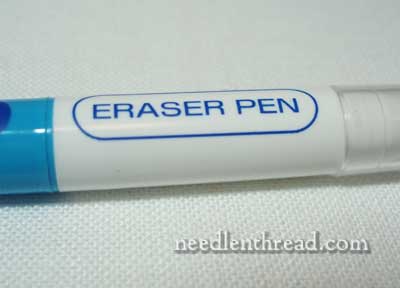
Since the blue side is water-soluble, at first I thought the white side was a little gimmicky. But I suppose it is to remove immediate mistakes from the design as you are transferring, with relative accuracy, and without having to use water that might spread and eradicate the rest of the design. Ok. That makes sense.
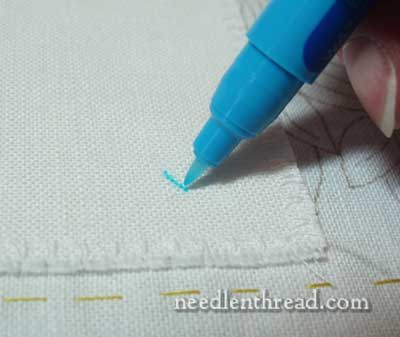
This is my “huge” test. I just drew a small line on the corner of a piece of washed linen. I figured a tiny line would tell me what I wanted to know. So I marked the line in blue…
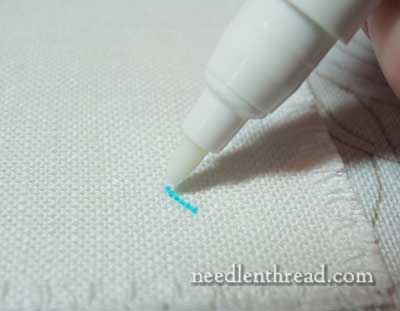
… and then I took the erasable side…
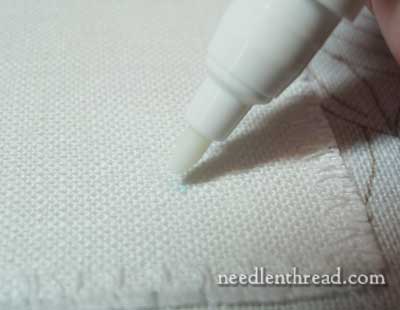
… and I erased it. Voila! The line magically disappeared! Actually, there was still the faintest trace of the blue, so I used the eraser pen on it two more times to see if I could totally remove every faint trace, but a little shadow still remained. But overall, yes, I would have called it erased. Had I stitched over this area, the ever-so-faint trace would not have been evident, right? Fine.
And you know, I left it at that. I went on to something else, and left the piece of fabric sitting right there, and … I never really thought about it again. The eraser thing seemed to work as indicated – the line was more or less gone – and I could see how the thing would be handy for folks who prefer to use transfer pens.
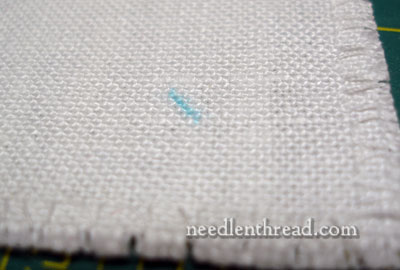
But then, two nights later, I was back out in my workroom gearing up for a short stitching session. While putting stuff away, I came to the piece of linen that I’d drawn that tiny little line on and then erased so thoroughly.
Guess what? The mark had magically reappeared!
Now, if I had transferred a design using this pen, and had made a mistake or changed my mind about the transfer and had used the eraser part to remove the mistake, and if I had then been stitching the design, and the stuff I didn’t want had begun to reappear, I think I would have been irritated. I certainly would have called the eraser part gimmicky.
Incidentally, the one event that turned me off water-soluble pens happened about six years ago, when I was working on linen using white cotton a broder. After finishing the piece, I soaked it in water as the directions indicated. The design transfer was all gone, and I left the linen to partially dry. As is my habit with this type of linen piece, I ironed it the rest of the way dry from the back (on a softly padded surface), to achieve that desirable crisp linen look. This is something I have always done with linen, and it has always worked well. But what to my wondering eyes should appear in the midst of this ironing job? Yes, the blue lines – here and there – fainter than they had been originally, but there nonetheless, and there ever to remain, because they wouldn’t come out afterwards.
If you do choose to use a water-soluble transfer pen, one of the hard and fast rules seems to be never to iron your fabric before you remove the marks. But you know, you should be able to after the marks are gone!
Following this, I examined another piece of linen stitched with white coton a broder, which I had finished the previous year, on which I had used a similar (though different brand) pen. Whew – no blue lines!
….. But wait….. no, there were no blue lines… but there was a yellowish hue around the design. At first, I thought it was a shadow, but everywhere the pen had touched had actually turned yellow. Not a bright yellow. But yellow nonetheless. And it was there permanently. And I resolved at that point, not to use transfer pens ever again on anything of any real value to me.
This doesn’t mean that in all situations, the same thing would happen. Many stitchers have used water soluble pens to good effect and have not had disappointments. As I said above, for cotton on cotton, especially in color, I’ve used them without any noticeable problems. I especially use them in my summer children’s embroidery classes, because with children, it’s a fairly easy way for them to draw a design that will wash away.
But you might want to think twice before you use this type of transfer pen on anything that you plan to treasure or to give away to someone else to treasure – and on anything in which you might make a greater investment for fabric and threads and time. If you’re absolutely confident that you won’t have any problems, sure, go for it! But if you’re not, I always say better safe than sorry.
What about you? What are your experiences with these types of pens? Do you use them? Are your experiences always good, or have you had some disappointments with them? Do you avoid them for any particular reason? Any input? Feel free to leave a comment and let the rest of us know!
Tomorrow, I’ll show you the new RSN blackwork book up close, and hopefully, I’ll have threads to show you for the pomegranate corner wool project by the next day!







I never had any trouble with the blue water soluble pens until I used them on an expensive piece of linen twill (wouldn’t you know it). I had traced my pattern and had stitched part of the design. Things came up at home and I didn’t get to work on it for about a month. When I went to work on it again all the blue was gone! I was left with a partially stitched piece that led nowhere. So I had to retrace the design, this time with a 3H pencil, trying to match the design lines to what I had already stitched. So like you, Mary, I would use a blue pen again on experiments or things that didn’t matter that much, but not on a piece that I would give away or considered a piece of art.
I’m wondering and thinking that the white end of the pen would gradually pick up the blue after being used a few times and eventually just leave more blue behind when trying to “erase.” You know how yellow highlighter pens pick up ink from texts and then the yellow isn’t so yellow any more.
It’s true! This happened to me also. I wet the piece after finishing the work and while still damp I pressed it in order to set it nicely and the marks not only reappeared but smeared. Fortunatly I was able to wash them again and let it fully air dry and oh so carefully ironed it again but lowest setting.
I make draperies and soft furnishings, and I like to use the Marvy Erasable Fabric Marker. It comes in purple and pink. The only problem I have is I use them so much they dry out too quickly. They will work great for embroidery projects. I mainly use chalk pens or clay based marking chalk for marking fabric where I need to make my cuts.
I have noticed that if I use the “eraser” end of the marker on white cotton fabric, then it will leave a slight yellowish color. I’ve never tested anything like denatured alcohol or distilled water to see if that would make any difference in removing the marks or the stains. If you leave the marks alone, the color will eventually disappear. If the color disappears too quickly for you, you can steam the fabric, and the marks will magically reappear.
I love your posts.. you have alot of useful information. I would never have thought that the ‘erasable’ pens would not ‘erase’. Thanks for the research. Keep it up!
In my experience the blue marking pens are erased with cold water and set by heat. Heat includes leaving something in a car on a hot day, or outside in the bright sunlight, using an iron, etc. I use these blue quilt marking pens on needlepoint canvas, not any other fabric, and I do think fabric sizing makes a difference. I have had the blue pen marks not come out of one brand of NP canvas while they work well on another brand.
I’ve tried the purple marking pens that are supposed to fade away. They work but are greatly effected by humidity. I’ve had the purple pen lines last for 2 weeks (in cold New England winters) and vanish overnight (in humid summery Virginia). I’ve also heard from folks who say the purple marks never disappear!
These things sort of work but you can’t count on them. I use my blue pen with caution and only on items I am going to completely cover with NP stitches.
Mary I am with you on the fade out and wash out pens. I put a lot of work into a major project and each time I tried to remove the blue mark it kept moving further and further away. It was the train on my daughter’s wedding dress that I had handbeaded and embroidered. I was devestated, but patience and lots of silent prayer’s worked.
In my mind they are craft pens for arts and crafts and not great at that either. I now use a soft lead pencil and it will come out with the old fashioned ” Ivory ” bar of soap.
I’ve used the blue pens (although not the one reviewed here) many times with only one misadventure. It was on a cheap piece of cotton fabric, and the marks wouldn’t come out. They turned brown after a few efforts to remove them. The “brown” made me think of iron stains, for some reason, so I tried one of the Carbona stain removers for rust and it worked.
But what’s a stitcher to do? If I used the micron pens, I’d be in trouble if I made a mistake. I once used a regular pencil, as instructed, on a piece of white-on-white embroidery. When I’d finished, the pencil black had worked its way into the embroidery, leaving me with a dingy-looking monogram. I soaked it and tried different stain treatments, but it never really came completely white again. You can’t scrub something like that.
When I took a whitework class at the RSN, my tutor had me transfer the design with a very fine pale blue mechanical pencil. Then we hooped a piece of tissue paper with the piece before stitching. We removed the tissue on each area as we stitched to keep the piece clean and the pencil from smearing. That worked pretty well, and the blue of the pencil seemed to function like laundry blueing, keeping the white “white.”
Very interesting topic!
Thanks for the info about the marker. I have one request. Please give us your thread list in advance (brand and color #’s) along with where it is purchased and while it is on sale. I would love to follow along with some of your projects.
You have motivated me to finish some projects and start others. I love your info about new products.
Où achetez ce crayon?
Merci
I’ve read where people say it’s ok to iron over that blue pen, but I learned a long time ago – it’s NOT!
I made myself a new spring cardigan, in a lovely peach color. I had used my blue pen to mark buttons and buttonholes. I spritzed them good with water, to wash out the pen, and let my jacket dry. I ironed it, I wanted to wear it to church the next morning.
Halfway thru church, I look down and notice all these blue marks ‘come back to life’! oh it was embarrassing. As they were all the way up and down my cardigan, I could hardly hold enough of anything in front of me to cover them up.
After that….no more ironing the blue pen, and I use it very carefully now.
Like you, I learned the hard way the negatives (which, in my opinion, far outweigh the time “saved”) associated with these type of pens: drying out too quickly, not coming out when they’re supposed to and coming back again like bad ghosts to haunt my sewing. Thankfully, I never used them with my embroidery because I was a chicken!
I have never had any problems with either blue washout pens, air erasable pens, or lead pencils. Once I had left blue washout markings on cotton for over a year but they washed right out. I have heard that the blue pens were formulated to work on synthetics, so using them on cotton or linen may not be the best use for them. I have heard people who think that lead pencils are “evil”, but the marks have always come out for me after washing in OxyClean and Tide. I only use the air erasable on silk for temporary markings, and I generally dry clean my work after finishing. I have never used the brown micron pen as I’m afraid of making a mistake, but am anxious to try the Martha Stewart moonstone pen. In fact, I have a coupon for a MS craft item so maybe I’ll stop at Michael’s on the way home.
Thank you for this valuable information, Mary! I had my suspicions about those pens, and you confirmed them for me. With all the work we put into our projects, who needs that aggravation? I am also glad you told us about those Martha Stewart pens–a must-have!
It sounds like this eraseable pen is more like the color changing markers for kids. It’s not eraseing/removing, it’s using a chemical reaction to change the color. I’ve not used any of the blue/purple pens. I keep forgetting I have them when I go to sew something. I have seen on sewing blogs and forums the issue of thinking the blue has been washed out, but reappearing when ironed and variability on how long the marks stay visible on the air-erase pens. That makes me a bit leary of using them. Unless as has been pointed out, using them only where marks will not be visible when the project is completed.
Yup – don’t trust ’em! I always heard that and always stayed away from them — except sometimes it is just SO EASY to grab one just to mark that one little thing…… I have some lines to this day that still appear on the lining of my wedding dress — and I made/wore that 18 years ago. Fellow embroiderers have their own horror stories, as well. In my way of thinking, they ARE chemical — and the chemistry leaves a mark on the fabric whether you actually SEE it or NOT. And you cannot trust what that chemical might interact with (or eat away at) in the future, so don’t!! I mostly use a Dixon washout (blue) pencil, or baste on the design. For crewel and other heavy applications, I will use the Micron (brown) marker if I am sure of total coverage. Thanks for the topic discussion, Mary. It is all basic information that rarely gets talked about.
Greetings from New Zealand
I do not like blue wash away pens, and have stopped using them for my stitcheries for all the reasons above. I use only green Artline pens – here is a link to the product: http://www.mta.co.nz/product?KEY_ITEM=SX954&KEY_ALIAS=SX954
I am not sure if they are available worldwide.I have also tested six other brands of green ink pens that are available in NZ with almost total success. With all brands none of the markings came back after ironing and only one left a slight residue which came out with a little washing detergent. My method is to trace the design, stitch it out and soak the completed stitchery in a bowl of cold water for a couple of minutes. The water will turn green!Keep rinsing in fresh cold water until the marks have completely gone. This doesn’t take long at all. My experience is that only green works, not red, blue or black.
Has anyone else tried this?
Arggggg! I just did a tutorial on my blog about making a heart. One step in that tutorial I suggested using an air erasable pen to mark the stitching line around the perimeter of the heart. I would hate to have someone follow my advice only to have the line return in the future or to stain the fabric. In this situation what would you suggest? A faint pencil line? Stitching through a paper pattern? Is it only water soluable pens or are air erasable the same?
Deb
Hi, All! Thanks for your comments about the pens. I see we’ve mostly all shared some sort of similar experience…
Hi, Deb – there are lots of ways to transfer a design; it just depends on the fabric, the design or type of stitching, the threads…… If the stitching line is going to be completely covered, and if you are working in colored threads, I don’t see a problem using a light hand with a hard lead pencil. I personally wouldn’t trust either the air or water soluble pens if there’s any doubt on the project you’re working. Again, on these that you don’t consider major projects, or on things that you can wash rather vigorously, then maybe it’s a different question…..
Anna – thank you for the link to the artline pens. They sound good – I may have to try them. I’ve actually had good success with removal of the papermate green ultra flair pen, though I have heard that the longer the pen remains on the fabric, the more difficult it is to remove.
Thanks Again, Everyone, for your feedback on this issue. I think it’s a good topic, and I think it’s good to know other people’s experiences with these types of pens!
~MC
I’ve used the purple pen & love it. It always disappears. The other end of the pen, is “Mark-B-Gone”, a blue ink, but I don’t know what purpose it serves. I never use it.
hola Mary”siempre al marcar un trabajo ,la linea no se borra,pense ustedes por ahi tenian la formula segura
tengo un hermoso cojin en capitone’al no existir aqui esos marcadores utilice ,,,grafito
lo lave muy bien”y las lineas siguen ahi
para otra vez tendre que hacer solo puntos
un gran saludo
Gracias por esta informacion:voy a buscar este lapiz pero creo que aca aun no lo venden.
I don’t know about this pen but over the years I’ve tried every pen/pencil the embroidery shops have stocked. None of them satisfied me. But recently you wrote about archival pens. Had a look around online then one day I went to a local art shop to look at them. I haven’t looked back since. That lovely fine line which gets absolutely covered with embroidery. Doing thread painting at the moment and apart from the outlines I keep picking it up and putting in a few directional lines for the stitches. So, thank you Mary. You’re the best thing that’s happened to embroidery since sliced bread !
Bonjour,
I’ve been visiting your site for a longtime, but I’ve never left any comments because I’m french and It’s a long time I have not written or spoken in English. Today I dare and I hope I’ll be understandable!
I very often use water-soluble blue pen, and it’s not rare that the blue color reappears.
I’ve tried a lot of different marks and the Clover pen (the one you tried) is the only one witch the blue color doesn’t reappears (except using the eraser part of the pen!): I wet totally the part to be erased (I use a spray when the work is not totally finished).
But it’s true that I am always worried to use water-soluble blue pen. I’ve tried other manners but I found nothing which satisfies me. Either it does not get erased well or it fades too well (before having finished).
it’s a constant preocupation for me and I spent a lot of money in trying something else.
To Viviane :
Je trouve les feutres bleus effaçables à l’eau de la marque Clover surtout dans les magasins de tissus patchwork.
Ils sont moins faciles à trouver que les marques Prym ou Bohin et beaucoup plus chers.
Hi there Mary,
Ah, this has happened to me. Luckily, like you just testing it out first on a scrap of fabric.
Mine disappeared………….but then I noticed in tiny print, it mentioned that over a certain temperature, the pen marks may return.
So, it went and then it came back. Living here in Turkey and high temperatures means, I can’t use the pen!! Can’t remember which make it was. I think I probably threw it away so I would use it by mistake and ruin a project…………
I usually use a blue Dixon (chalk) marker to mark most of my projects. It does require hours of soaking in cold water only to remove the marks afterwards, but they do come out.Have never trusted the water soluble markers for all the reasons given.
Hey, Y’all, Mary, thanks for this. I have a collection of pens and pencils. All say either water erasable or air erasable and they all have come back at one time or another. I’ve found that, for white work, putting salt, lemon juice and sitting the thing in the sun, then washing will take most of them out. I have just retired most of these. I’m using a blue lead, no wax architect pencil right now. That works much better, fine line, controllable and blue blends in, as others noted.
I just got some transdoodle transfer paper. Have you ever used that, Mary?
Also, YLI has some new pens that you mark on the wrong side of the design, then iron on. Has anyone tried those? Thanks, AnneG in NC
I have been put off using these pens by all your comments as well as some by other people. Most of my work is on crazy quilting and so each ‘motif’ is pretty small usually. I used to use the air drying purple pens but found that the lines were too thick and that the lines disappeared.
So I would like to know more about this Martha Stewart pen that Cynthia mentioned. Has anyone actually used it, and if so how did it pan out?
Also if anyone has any good tips for transferring or even just straight drawing designs onto all types of fabric I would love to hear them.
Thank you.
Hi, Christina – the Martha Stewart pen is permanent – it won’t disappear. The advantage of it is that it draws a very fine line that is easy to stitch over, and in the “moonstone” color, it is a rather pale greyish-tan line, also making it easier to cover. But it doesn’t disappear! Once it’s there, it’s there. I haven’t used it on silks at all, so I don’t know if it will bleed, but I’ve used it successfully on linen and cotton. ~MC
Mary, at one time you commented on Flair green and blue pens. Have you checked to see it the colors remained gone? Let us know please. I keep experimenting and found so far the Micron sepia pens are the best, though permanent. you just have to make sure you cover the marks with stitches.
Hi, C – Yes, the color remained gone with the Flair pens. Because they are water-based, when the wash out, they wash out. I’ve heard from others, though, that if the Flair is left on for a long time – months to a year – it is more difficult to remove. So if you’re going to use them, I’d use them with caution on projects that don’t last too long. ~MC
I’ve been using blue fabric markers for years. Now, suddenly, I’m unable to get it out of the piece I’m winking on. Granted,it sat around for a few months, but I’ve let a penned pattern set before, without harm. But now, tho the blue disappeared completely with soaking, it reappears when it dries. Have the mfgrs changed the chemical formulation?
Perhaps the formula has changes – but whatever the case, I’m pretty wary of these types of markers. It seems the longer they’re on, the more difficult for the removal to be permanent. ~MC
Hello Mary,
doing watercolors a trick I used to “erase” areas was straight bleach. It even works with very permanent colors. The brush will be a throw away (even if you use dechlor on it) but the trick is to use chlorine remover used for aquariums. Look carefully when in the aquarium shop there are removers that work on chlorimine too. Try them out and see if it doesn’t work on cotton and linen only! i have watercolors that are 30 years old that I had removed large areas of color and re-colored with no deterioration of the paper whatsoever.
A product called “Liquid Squeegee” made for window washing makes use of a surfactant. (Probably any would get that blue line out) I have gotten berry juice out of fabric without washing using it. It is pretty safe for all fabrics.
I used the marker b gone and guess what it’s still here. I did a project where the kids signed fabric and I embroidered over the signatures. Didn’t test it and now I am sooooo sad. It disappears and comes back bigger and better. Not sure what to do. I keep wetting it down hoping it will eventually go away. SCREAM
We used fabric marker and forgot to take it out before I washed it with sunlight powder detergent. It turned brown and I can’t get it out. Do you have any ideas?
I have used Dritz Blue Water Soluble Marking Pencil. I have washed n dried my quilt and the blue did not come out. What can I do to remove the blue? Thank You
I do use those blue water soluble pens but make sure to properly rinse the fabric or quilt with lots and lots of water so the pen really disappears! I have heard about quilts with dirty spots for blue pen that stayed in the filling…
I traced a design onto a fabric using a blue ‘washable’ pen and then put the project away in the cupboard for a week or so only to get it out to find where the blue was had eaten into the fabric. I definately will never use again
Try soaking your project in cold water mixed with vinegar. I just saved two applique projects that had been washed and dried (one was even ironed) and the blue lines were very prominent. I washed them on the lowest water setting and added 2 cups of vinegar. I let them agitate on the hand wash setting for about 30 seconds and then stopped the machine and let them soak overnight. Every bit of the blue came out. I don’t know how to estimate how much vinegar per gallon of water to use exactly. If you have a big project that needs water at the full load setting, maybe use a gallon of vinegar. Good thing it’s cheap. I’m thinking of putting straight vinegar in a spray bottle and seeing what the marks do when spritzed.
Hello from South Africa
Do you possible have any tips for removing the “yellowish discoloration” around the embroidered part?
My mom passed away last year and I found some beautiful hand embroidered linen squares (enough for a table cloth) in a very old shopping bag in her needlework room, but about half have the yellowish tinge around the design. They must be at least 45 years old – can tell because the shop ceased to exist around them.
I am feeling quite sentimental and would like to put them together as a remembrance of Mom, but would like to get the stains out first. I have tried oxygen pre-treatment and a good detergent but on some squares the marks are still there. Any help would be appreciated. I see suggestions for vinigar or window cleaner in this discussion – which would your try first?
Thanks Vicki
Hi, Vicki – There’s a product called “Restoration” that’s supposed to be very helpful with yellowing from age and storage. You might look that up – it works well on whites, but I’m not sure if it will work with colors, so if her embroidery is done in color, it might not be the thing to try. You can also try the lemon juice and sunshine trick – rub the yellowed areas with fresh lemon juice and lay out in the sunshine for about half an hour – that could do it. Just be aware that the acid from lemon juice is not great for delicate fabrics, but if the fabric’s in good shape, it’s worth trying. Finally, as a last-last resort, there’s always a diluted solution of bleach, but again, if color is involved, I’d be careful with that.
I drafted my ‘challenge” quilt last May for judging this month (March). After pressing my white cotton, I traced over my draft with clover wate?r soluble pen. Lovely lines to embroider, applique and quilt. When I added one border after months of work, I must have touched a few spots with iron when pressing seam. Now some of the blue lines have returned close to this border in spite of numerous spritzing. Does anyone have any solution to this problem
Hi, Sue – instead of spritzing it, you might have to soak it for a longer period of time. That might help…
A friend just called and said she used the purple pen on a quilt and the markings did not disappear. Is there any way to remove this stain. Only thing I knew was she should not apply heat to it, but how do you get it our?
Some are water soluble. Has she tried rinsing it at all? She might try that. Hopefully, it will work!
Hi Many thanks for this piece of research. Having only just learned that these pens existed I googled to see where best to buy one and this was one of the sites listed. Having read your post I will do without these pens and carry on as I have done before, I am sio grateful that thus I will not ruin my needle work or waste my money thanks to your kindly warnig. Very much appreciated.
Best wishes for the futer, Linda 🙂
I use water erasable pens and until today never had a problem. I embroidered a door which I outlined with the pen. When I wet it to make the blue disappear red dots appeared and then pink lines. I cannot get rid of them. Has anyone had this problem. It was Avery strong blue.
I have used these pens for years with no problem. However I have just smocked a piece of white cotton lawn in white thread. I used the pen for accuracy. Just finished, it was quite a deep piece of work, went to sponge it of it wouldn’t erase I became a little more vigorous no joy so I completely submerged it in cold water, still no joy I have now washed it in warm water with gentle soap still not gone. This is quite expensive fabric plus many evenings work washed.
Did you find anything to remove the yellow? Im upholstery a couch with velvet and yellow spots have appeared on one peice i have inatalled (of course with diamond tufting all over it so im strugglinf to access the problem areas. No issues on back of couch but this side piece has mutiple yellow marks on the good side (i marked the back). I read someone else has issues when a water erasable pen reacted with permanent pen reside on the ruler. I dont have enough fabric to redo and im not sure what to try remove it as i cant replicate the problem onna scrap. Any ideas?
I have maded a King size Candlewicking quilt. I used water eraser pen to mark out design before embroidered. Before I sewed the wadding on I got it dry cleaned and I now have gold marks were the pen must have been and they weren’t there before I got it cleaned.
So don’t use pen on anything with great value and spend hours and hours making